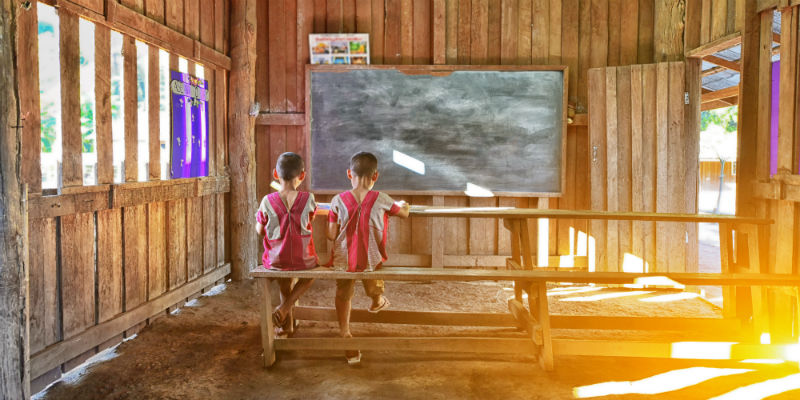Poverty often shows itself as a lack of basic necessities, but governments and aid organizations must resist the temptation to blindly invest in providing—or pushing—resources into poor communities.
If that sounds counterintuitive, that’s because it is.
According to the CDC, 780 million people lack access to safe water; more than 2.5 billion people do not have access to proper sanitation; and almost one million children under the age of five die annually due to diarrhea, a very preventable sickness. The standard response is rational—where there is no water, we should build wells; where there are no toilets, we must build toilets; where there are no schools, we must provide schools. Unfortunately, though well-intentioned, these solutions are little more than a bandaid.
Consider the push for free universal basic education, which has been a major item on the agenda of many African governments and experts in the global development industry over the past two decades. Undoubtedly, attending school may confer numerous individual and society-wide benefits: offering children secure childcare during the day, socializing young people into a community of peers, and so on. Yet even when the billions of dollars of investment in education infrastructure have succeeded in getting children consistently into a physical classroom, learning at most schools is very poor. Literacy and numeracy assessments show that students in low-income countries perform worse, on average, than 95% of students in high-income countries.
It turns out that building schools and herding as many students into classrooms as possible hasn’t unlocked the potential academic and economic benefits of school, and career outcomes are faltering.
What of the clean water crisis? Surely this is an instance where an influx of resources—wells or other infrastructure—could solve the problem. That’s what I thought the first time I visited a community where people did not have access to water nearby, leading me to rally some friends together and raise $10,000 to build a well. We later built four other wells, but they all practically stopped working after less than a year of operation.
Our experience is far from unique; the United States, for instance, has spent more than $360 million on rural water supply schemes in Africa and other regions that have broken down and no longer work. When outside actors provide communities with wells and water treatment infrastructure, too often no sustainable mechanism exists to maintain them. Regrettably, the situation is virtually the same for toilets.
On the issue of toilets, let us consider India, where 44% of the population continues to practice open defecation and just 39% of people living in rural areas have access to sanitation. This has deleterious effects on society as diarrhea kills millions of children annually. The Indian government, in response to this problem, has built 90 million toilets, and hopes to reach 111 million by the end of the year.
While providing increased access to sanitation is making a dent in the problem, the government is also learning a hard lesson: building a toilet is one thing, getting people to use it is quite another. The minister for rural development explained, “For long, we assumed that if the toilets are built, people will automatically use it. But we have to diligently monitor the use over a period of time and reward them with cash incentives to the village councils at every stage. Only then will it become a daily habit.” Adding further complication to the challenge, the government has had to roll out an entire set of services to support the maintenance of the toilets. Even if the government succeeds in meeting its goal, the verdict is out whether the program will be sustainable. Perhaps the push to spend billions of dollars building toilets is not the right move.
So what can be done?
Rather than push what are essentially outputs of prosperity, government and development professionals should start by asking themselves, “How did prosperous countries get rich? Did they get significant amounts of money which were directed at education, toilet, and water projects?” The answer, of course, is no. In fact, many of today’s wealthy countries created prosperity by fostering cultures of innovation, and one type of innovation in particular: market-creating innovation.
Market-creating innovations transform complex and expensive products into simple and affordable ones, enabling more people to benefit from them, and creating many jobs in the process. What makes them so special? The markets they create unleash a domino effect of sustainable economic development, lifting thousands, if not millions, out of poverty in the process.
Consider how Safe Water Network has created a market for affordable, safe drinking water in the more than 300 communities where it operates.
It works like this: the nonprofit identifies entrepreneurs within communities where it works, provides them with the necessary equipment for pumping and purifying water, and trains them to sell its services at a price most people can afford—creating revenue to cover operating and maintenance costs. Through this model Safe Water Network not only creates jobs but ensures its service is sustainable. The organization is on track to double the number of people its entrepreneurs serve by 2022.
The truth about providing resources is this: schools may help temporarily, providing toilets may seem like the right thing to do, and there are few feelings more gratifying than providing water to a community in need (trust me, I have felt it many times). But these solutions rarely last, and often fail to live up to their promise. By contrast, market-creating innovations create sustainable solutions and jobs, paving a way for people to lift themselves out of poverty. I never met a person with a decent job who still drank unsafe water.


